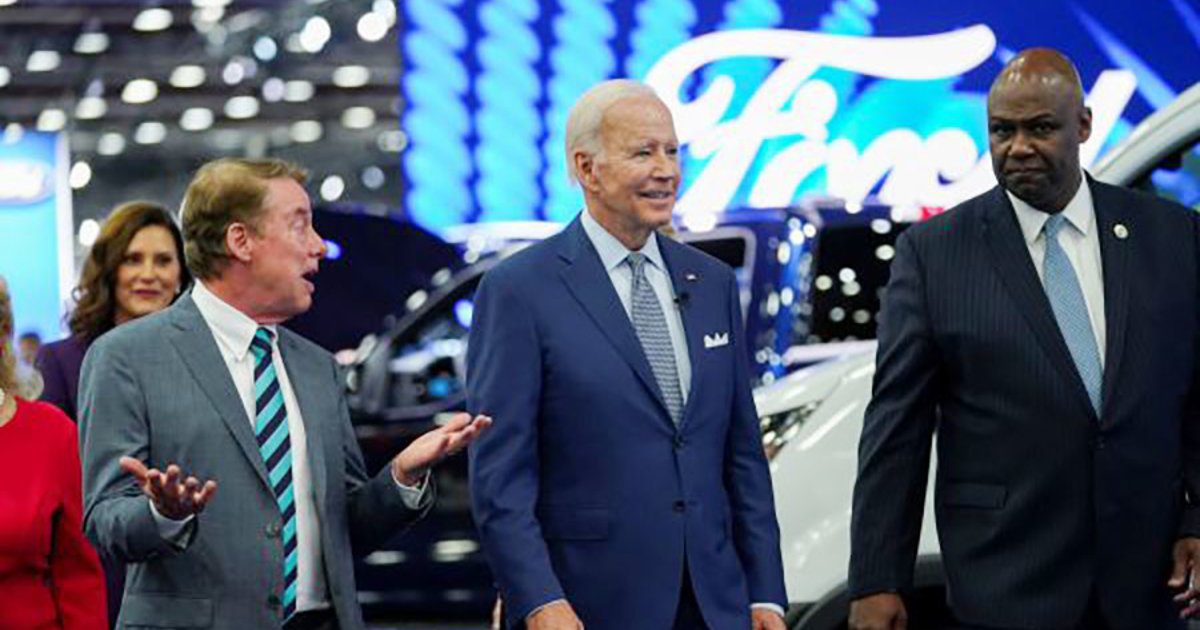
While the federal government hurries to approve state plans to support an electric vehicle charging network across the country, President Joe Biden is busy visualizing the end goal.
“The great American road trip is going to be fully electrified,” Biden said Wednesday in a speech at the Detroit auto show, his first visit to the event since he was vice president in the Obama administration. “Whether you’re driving coast to coast along the I-10 or on I-75 here in Michigan, charging stations will be up and as easy to find as gas stations are now.”
The president last year set an ambitious target for battery-electric, plug-in hybrid and fuel cells to make up 50 percent of all new vehicles sold in the U.S. by 2030. And, to speed up EV adoption, his administration is working with states to build 500,000 EV charging stations with funding from the $1 trillion infrastructure law.
As of Wednesday, the Biden administration has approved 35 of the 52 EV infrastructure deployment plans submitted by states and U.S. territories ahead of schedule under the National Electric Vehicle Infrastructure Formula Program.
The program — created and funded by the infrastructure law — makes $5 billion available over the next five years to help states achieve Biden’s vision of a cross-country road trip that is compatible with EVs.
States had until Aug. 1 to submit EV infrastructure deployment plans to the Joint Office of Energy and Transportation, created by the U.S. Energy and Transportation departments in December to assist with planning and implementation of a national EV charging network, including distributing funds to states.
Plans submitted by Arkansas, California, Georgia, Kentucky, Michigan, Pennsylvania, Tennessee and Wisconsin are among those approved. District of Columbia and Puerto Rico plans also are approved.
The approval unlocks more than $900 million in funding in 2022-23 to build EV chargers across roughly 53,000 miles of U.S. highway, including interstates and alternative fuel corridors, according to the Federal Highway Administration.
“The plans are really about trying to build a backbone,” said Nick Nigro, founder of EV research group Atlas Public Policy. “It’s very comparable to what the interstate highway system did for car travel, or what building out the national electrical grid did for access to electricity.”
The challenge now, he told Automotive News, is ensuring the process goes smoothly.
“For many of them, this is going to be a new endeavor, and they might not have as much relevant experience as needed to make sure that the process is successful in the early days,” Nigro said.
Reliability of EV charging equipment is another hurdle, he noted.
A 2022 J.D. Power survey of 11,000 owners of EVs, including plug-in hybrids, found one out of every five respondents was unable to charge their vehicle when visiting a public charging station. Of those, 72 percent said the station was malfunctioning or out of service.
“Companies are having trouble putting equipment out there that works to meet consumers’ expectations,” Nigro said. “While you can have these requirements built into your program — and many states already do, and utilities already have requirements about reliability in their program — actually delivering on that reliability is another question.”
To be sure, federally funded projects must adhere to certain criteria as mandated by the law, according to Federal Highway Administration guidance.
The agency in June proposed a rule on the minimum standards and requirements to ensure EV charging stations are accessible, user-friendly and interoperable among different charging companies and across a broad range of vehicles. It plans to finalize the rule “expeditiously.”
As of June, there were a total of 100,111 public charging outlets scattered across 44,698 locations in the U.S., according to the Alliance for Automotive Innovation, an industry trade group that represents most major automakers.
For context, 420,546 EVs have been registered since the start of 2022 but only 12,603 new chargers have been installed. That’s a ratio of 33 vehicles for every public port, the alliance explained.
“The data on public charging remains an area of concern and something the White House is rightly focused on,” said John Bozzella, CEO of the alliance. “We’re not adding public charging in this country nearly fast enough to keep up with EV sales. That’s the key to overcoming range anxiety and to convincing drivers who might be on the sidelines that going electric is right for them.”
Loren McDonald, CEO of analysis and consulting firm EVAdoption, said the state plans will help fill in some of those “charging deserts.”
“Probably one of the single biggest benefits of NEVI is it’s actually going to put in these charging locations where the private charging networks are not putting them because of low utilization,” he said. “It is going to really help fill in those charging gaps.”
Funding through the program is first directed to designated alternative fuel corridors and interstate highways to start building out the national charging network. Once fully built, funding can be used on any public road or in other publicly accessible locations, according to the guidance.
With federal funding, “states are providing a foundation in which to build on, but it’s not the end game,” Nigro said. “There’s got to be an incredible amount of investment, considerably more than what the states are doing right now. Most of that’s going to get done by the private market in order for us to get to where 50 percent EV adoption is possible nationwide.”
Nigro’s group estimates somewhere near $40 billion is needed this decade to fill additional gaps in publicly accessible charging.
“By any measure, we still have a long way to go before we hit the goal the president has set out,” Nigro said. “There’s a lot more infrastructure that needs to be built before EVs are really easily competing against gasoline vehicles in every market.”